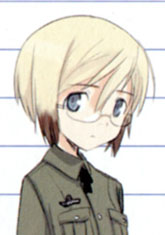
Hauptmann, Luftwaffe des Karlsländisches Kaiserreich
Captain, Imperial Karlsland Air Force
"Karaya-2"
Avalon County Entertainment System
Channel Select: Avalon Broadcasting System (Channel 17)
Program start
Flying Yak Studios
and
Bacon Comics Group
in association with
The International Police Organization
and
Avalon Broadcasting System
present
Lensmen: The Brave and the Bold
Our Witches at War
another serial experiment
© 2015 Eyrie Productions, Unlimited
Character Profiles
Witches Belonging to Other Units
As the title implies, these are witches who do not belong to the 501st or 511th Joint Fighter Wings, but who may be relevant to the story at some point, or who are simply interesting.
 | Ursula "Usch" Hartmann Hauptmann, Luftwaffe des Karlsländisches Kaiserreich Captain, Imperial Karlsland Air Force "Karaya-2" |
Nationality: Karlsland
Date of birth: April 19, 1928
Familiar: European badger
Striker model: Focke-Wulf Fw 190D-12 Würger
Weapon of choice: MG 42, Fliegerhammer
Notes: Erica Hartmann's twin sister, and the younger by several minutes. Rather more buttoned-up than her elder twin, but not prim about it. Ursula served for some time with the 507th JFW based in Suomus, but of late has been back with her original outfit, Kampfgeschwader 200, Karlsland's experimental flight test and special operations unit (currently based at Juvincourt Airfield, Karlsland's largest airbase in Gallia). Although a competent combat witch, her real talent lies in engineering, which is why she's with KG 200 rather than lighting up the leader board like her sister. She divides her time between aircraft and weapons research, and is fairly well-known among witches as the principal inventor of the Fliegerhammer multi-rocket system. She's also a member of the development team for the Me 262 and is rumored to be working on her own independent jet Striker design based on lessons learned from that project. One side benefit of her posting back to KG 200 is that, since the wing is based within a fairly easy flight of Ribeauvillé, she's able to visit her sister much more easily than she used to be when she was based in Suomus or Neukarlsland.
Her callsign is an inside joke, only employed by the 501st; on operations with KG 200, she doesn't commonly use one apart from the rather pedestrian Versuch 1 ("Test 1").
Melitta Schiller
Hauptmann, Luftwaffe des Karlsländisches Kaiserreich
Captain, Imperial Karlsland Air Force
"Sturzi"
Nationality: Karlsland
Date of birth: January 9, 1923
Familiar: Kestrel
Striker model: Junkers Ju 87G Kanonenvogel
Weapon of choice: BK 5 heavy autocannon, BK 37 autocannon (x2)
At 23, Melitta ought to be winding down her career, and in fact she is... for certain values of winding down. Though she is no longer rated for combat (having, as is common, lost her shield not long after her 20th birthday), she's still an active test pilot, one of KG 200's best. Her specialty is what the Luftwaffe calls the Sturzangriff, "diving attack", in which a high-speed dive is used to increase the accuracy of a dropped or thrown explosive. Dive bombing has gone out of fashion - as a form of direct assault, it's dangerous, and there's no fallback position if it doesn't work - but Melitta is working on a revival of the tactic which uses the dive to stabilize the platform for a very heavy weapon, such as the BK 5 50mm cannon originally developed for the Me 262 jet Striker. She's also developed the first Striker with integral weapons, in the form of the pair of BK 37 37mm cannon mounted one apiece in the halves of her Ju 87G prototype. She's considered more than a little crazy... but the design does show promise. If it can be made operational, it will provide new uses for both the BK 5 (which was abandoned as one of the reasons the Me 262 V1 was too demanding to use) and the Ju 87 Striker model, use of which has declined along with dive bombing generally.
Since she works with weapons developed for the Me 262, that means she commonly works with Ursula Hartmann. Although they have developed a very close friendship in the process, the two - perhaps in a deliberate act of irony - always address each other very correctly as "Captain Schiller" and "Captain Hartmann".
Melitta Schiller is based on Melitta Schenk Gräfin von Stauffenberg, a real German dive-bomber test pilot - one of whose brothers-in-law was Claus Schenk Graf von Stauffenberg, a key figure in the July 1944 plot to assassinate Hitler. (Schiller was her maiden name.) Her callsign is short for Sturzbombardierin, "dive bomber girl".
 | Hannelore Augusta Ulrike Freifrau von Hammer Rittmeister, Karlsländische Luftstreitkräfte Captain of Cavalry, (Old) Karlsland Imperial Air Service "Höllenhammer" |
Nationality: Karlsland
Date of birth: April 12, 1901
Familiar: Grey wolf
Striker model: Messerschmitt Me 262 A-1A/U5 Sturmvogel
Weapon of choice: Mk 108 30mm autocannon (x2)
Baroness Hannelore von Hammer was a member, and ultimately rose to be commander, of Jagdgeschwader I of the Luftstreitkräfte - the original brigade of flying witches fielded by Karlsland in the First Neuroi War. In 1946 she's by far the oldest operational witch in the world, having defied the "Witch's Fate" for two and a half decades and counting, and has long since become the last of the "Originals" still in the air. Among the younger witches of the European Theater, she has a fearsome reputation. It's whispered that she maintains her power through sheer force of will. It's an open question whether that iron will or her vast experience has chiefly enabled her to tame the flawed and temperamental Me 262 Sturmvogel Jet Striker, a treacherous beast whose quirks have humbled more than a few of Karlsland's top aces.
Whichever, she's widely reputed to be cold and humorless even by Karlsländer standards: fiercely intolerant of the slightest fault, informality, or lapse in military discipline by her fellow witches. Many of her young colleagues would rather face the Neuroi any day than fly under the scrutiny of the witch they call the Hammer of Hell.
As a living legend and a personal confidante of Kaiser Friedrich IV (who, performing his family's traditional military service as Leutnant Friedrich Prinz von Preußen, served as her crew chief during the First War), von Hammer answers to no modern-day rank and belongs to no unit, but instead roams the Luftwaffe's area of operation as she sees fit. Her red Me 262 bears the old-fashioned Tatzenkreuz insignia of the Luftstreitkräfte rather than modern-day Karlsland's Balkenkreuz.
 |  |
| Tatzenkreuz, 1914-1925 | Balkenkreuz, 1925- |
(If she looks familiar to the Fly Girls fans in the audience, that's because the animators of Our Witches at War are having a little joke...)
Jane Harriet "Jenny" Doolittle
Lieutenant General, United States of Liberion Army Air Forces
"Wrecker
Nationality: Liberion
Date of birth: December 14, 1926
Familiar: Bull terrier
Striker model: North Liberion P-51K Mustang
Weapon of choice: M1919 .30-caliber Browning machine gun (x2)
One of Liberion's great aviation pioneers, Jane Doolittle began her aerial career in the spring of 1936, when she was nine - a tender age even for a flying witch. By the end of that summer, she had hedgehopped her way around a complete circuit of the continental United States, the first aviator ever to accomplish the feat, using a First Neuroi War-vintage Curtiss JN-4 biplane Striker nicknamed "Jenny". So many reporters covering the flight assumed that the aircraft's name was her own that she eventually gave up trying to correct them, and has been Jenny Doolittle in the public's mind ever since.
After joining what was then called the Army Air Corps in 1937, Doolittle invented the technique of "perception flying" - using magical means to correct for the natural errors in situational awareness caused by impaired visibility - and greatly improved the safety margin of night and bad-weather flight for witches. (This ability is often confused by laypeople with magic radar, but the two disciplines are entirely separate. Magic radar is a specialist technique very few witches can employ, while all flying witches can be, and as a general rule are, taught at least the basics of perception flying.) By 1938, Captain Doolittle was one of the loudest voices calling for the Liberion forces to develop Miyafuji Engine-equipped Strikers, and in 1939 Major Doolittle became one of the first Army officers to make a public call for her country to enter the war against the Neuroi.
All this agitation nearly got her cashiered, and in fact it was three years before the USL finally got into the war - at which point Lt. Col. Doolittle astounded and annoyed the brass again by propounding an absurdly ambitious first operation for the Army Air Force to undertake: nothing less than the destruction of the Neuroi Hive at Ufa in west-central Orussia, which threatened the evacuation of that country's major population centers to planned fallback positions east of the Urals. This was insanely far from any Liberion base or supply point, and the Army brass deemed Doolittle's plan, which involved a submarine launch from the Black Sea and a one-way ferry flight to Suomus with a bombing raid on a major Neuroi Hive in between, a suicide mission.
There were those who wouldn't have minded seeing Jane Doolittle get herself killed on a damnfool idealistic crusade, though, and either way it would be good press to offset the grumbling about Liberion's late entry into the war; so the plan was approved, with the proviso that all its participants must be volunteers. Some assumed Doolittle would never be able to talk a dozen other witches into undertaking the mission. Some were wrong. The destruction of the Ufa Hive opened the way for the evacuation of some 80 percent of Orussia's population and cemented the reputation of the witch the papers were now calling "Jenny the Wrecker" all over the world.
Now the Liberion Army's youngest-ever lieutenant general, Doolittle is the highest-ranking witch in that country's armed forces and head of all Liberion aviation assets in the Allied Expeditionary Force in Europe. In that capacity she is constantly butting heads with older, maler colleagues, who have their own (usually wrong, according to Doolittle) ideas of how "her girls" should best be employed. It's a hassle, but Jenny the Wrecker doesn't mind - it's just another hedge to be hopped.
As popular with the rank and file as she is unpopular with most other generals, Doolittle makes it a point to participate personally in at least one sortie a month, somewhere in the AEF's theater of operations. President Truman really, really wishes she wouldn't do that, but he can't stop her. No one can stop her. That, if you ask her, is kind of the point.
Jenny's archetype is General James "Jimmy" Doolittle, who people remember nowadays mostly for the 1942 Tokyo Raid, but who was, in fact, one of America's foremost aviators long before he did that - among other achievements, he pioneered instrument flying, won more or less every aviation trophy going in the '20s, and was the first person to perform an outside loop and not get killed doing it.
Witolda Urbanowicz
Flying Officer, Britannian Royal Air Force
"Bear Girl"
Nationality: Orussia (Polonia)
Date of birth: March 30, 1928
Familiar: Brown bear (see below)
Striker model: Curtiss XP-40Q "Super" Warhawk
Weapon of choice: M2 .50-caliber Browning machine gun, Fliegerhammer
Notes: In a series of stages between 1772 and 1795, the ancient kingdom of Polonia ceased to exist as an independent nation, its territory partitioned between Prussia (later to become the most politically influential part of Karlsland), Ostmark, and Orussia. Within a generation or two, the areas of Polonia that became parts of Karlsland and Ostmark integrated into those empires reasonably well. (For instance, Minna-Dietlinde Wilcke is from Poznań, in the Karlsland sector of Polonia, and has never considered herself other than a Karlsländer.) The area that became part of the Orussian Empire... didn't.
When the Second Neuroi War began in 1939, that area was already on the brink of a separatist uprising, and many of its witches refused to fight under the flag of a country they considered an alien occupier in its own right. Instead, they scattered to other Allied nations. A good many, suspicious of Karlsland and Ostmark as well as Orussia (for obvious reasons), fled farther west and joined the Britannian RAF. Witolda Urbanowicz, a mere child of 11 at the time, was one of these. She served with 303 Squadron ("Kościuszko") throughout the Battle of Britannia, rising to command of the squadron by the end of the campaign; but command was not to her liking, and once the Neuroi threat to Britannia was ended, she requested a voluntary demotion back to Flying Officer to get away from it.
This her superiors were only too happy to grant, because Witolda is a strange specimen even by witch standards. Disregard for military pomp and protocol is far from uncommon among witches, but she takes it to its logical extreme, to an extent that would probably get her thrown in the stockade if she wasn't a highly decorated volunteer to begin with. She's never worn a proper uniform because, as she points out, she doesn't have a proper country. Though usually cheerful to a degree that makes some people wonder whether she's on something, she has little use for Orussians and will avoid them if at all possible. She'll eat pretty much anything that isn't alive (and a few things that are), drink pretty much anything that's a liquid, and sleep anywhere that isn't actively harmful to human life.
For most people, though, the strangest thing about Witolda Urbanowicz is that her familiar is an actual animal. Virtually all witches' familiars are æthereal creatures, spirit exemplars of the animals they represent, invisible to all but the witches they serve; but Wojtek is... well, a bear. Undeniably. Rather than manifest his ears and tail on her own body when she's calling on him to boost her magical power, Witolda carries him, a full-grown Syrian brown bear, on her back. That he wears a uniform (he holds the rank of sergeant, RAF, and is officially listed as her crew chief), drinks beer, can handle a rocket launcher, and smokes Liberion cigarettes whenever he can find them is all just icing on that particular cake. It's little wonder that people seeing Witolda and Wojtek in action are left wondering whether she's crazy or they are.
Since leaving 303 Squadron, Witolda has been a military nomad of sorts, wandering the war zone with her Striker Unit, her trusty machine gun, her bear, and his Fliegerhammer, sticking their noses in wherever things look like they might be interesting. Along the way she picked up an experimental Liberion Striker (a performance upgrade to the venerable P-40 that's meant to make it competitive with later-model P-51s again), reputedly because she was the only one mad enough to agree to test it after losing her Spitfire in Persia in '45.
Apart from flying high-performance Striker Units in aerial combat while giving a full-grown brown bear wielding a rocket launcher a piggyback ride, Witolda's magical specialty, like Eila's, is foresight; and like Eila, she's never been hit by enemy fire (her Spitfire was destroyed on the ground while she wasn't using it).
Witolda and Wojtek's ace archetypes are, respectively, Polish RAF ace Witold Urbanowicz (who probably had a less quirky personality, but a similarly wacky career trajectory - after the Battle of Britain he flew P-40s with the Flying Tigers in China because of personality clashes with the Polish command-structure-in-exile!) and, well, Corporal Wojtek, the bear soldier.
Jacqueline-Yvette Cousteau
Lieutenant de Vaisseau, Forces Navales Galliaises Libres
Lieutenant, Free Gallian Naval Forces
Nationality: Gallian
Date of birth: June 11, 1930
Familiar: Mediterranean flying fish (Cheilopogon heterurus)
Striker model: Cherbourg Arsenal Minerve-class Sea Striker
Weapon of choice: Type 47 Jet Harpoon Rifle
Notes: While the flying witches get most of the press and the tank witches have their devotees, few outside of the world's seaports are aware that there are undersea Neuroi as well - and that there is a small corps of magic-wielding young women tasked with hunting and destroying them. These women, the sea witches, tend (unsurprisingly) to come from nations with long-established maritime heritages, many of them islands. Britannia and Fusō have produced many distinguished sea witches, as have Liberion and (mostly northern) Karlsland. Baltlandic sea witches, though rare, are renowned for their ferocity and their navigational skill.
But among the witches of the waters themselves, few names are more highly regarded than that of Jacqueline Cousteau. Sometimes described as "the Professor Miyafuji of the sea," she is renowned among her peers for having developed the first truly practical undersea Striker Unit. She would be the first to admit that she didn't invent most of the technologies incorporated in it herself - Sea Strikers are, for instance, based on the Miyafuji Magic Engine - but she was the first to bring them together and apply them to the problem of underwater counter-Neuroi operations. Before 1942, witches fought undersea Neuroi either by bombing them from the air, or simply by swimming to the attack. The latter technique was highly specialized, very dangerous, and not known for its overwhelming effectiveness.
The Sea Striker changed all that, enabling underwater-specialist witches to fight on terms similar to those enjoyed by their aerial cousins. Coupled with the development of effective undersea weapons such as the Type 47 Jet Harpoon Rifle, it made direct one-on-one engagement of aquatic Neuroi a practical reality. Sea witches are still uncommon, and rarely seen in action, but no military fleet goes anywhere without at least one somewhere in the vicinity. They take their obscurity as a point of pride. "If we're doing our job right," Cousteau has been quoted as saying, "you'll never notice us."
What fewer people realize is that the inventor of the Sea Striker had more in mind for her creation than combat against the Neuroi. From the start, Cousteau's mind was on the device's usefulness in a world without the Neuroi; her heart is that of an explorer, not a warrior. She dreams of a day when she can use her Striker to delve into the ocean depths she loves and share their majesty with the world, rather than fight desperate battles against alien aggressors.
Cousteau's magical specialty is limited flight; through concentration, she can propel her Sea Striker out of the water and perform short-range aerial maneuvers. This makes her a more flexible combatant than most, but is a very demanding technique and can leave her vulnerable to counterattack.